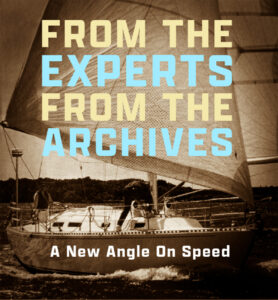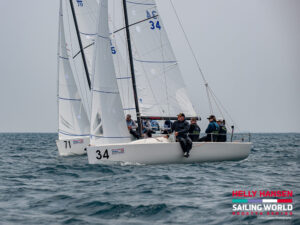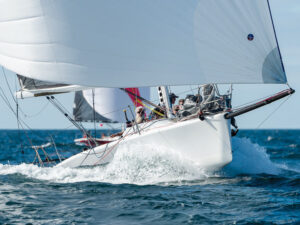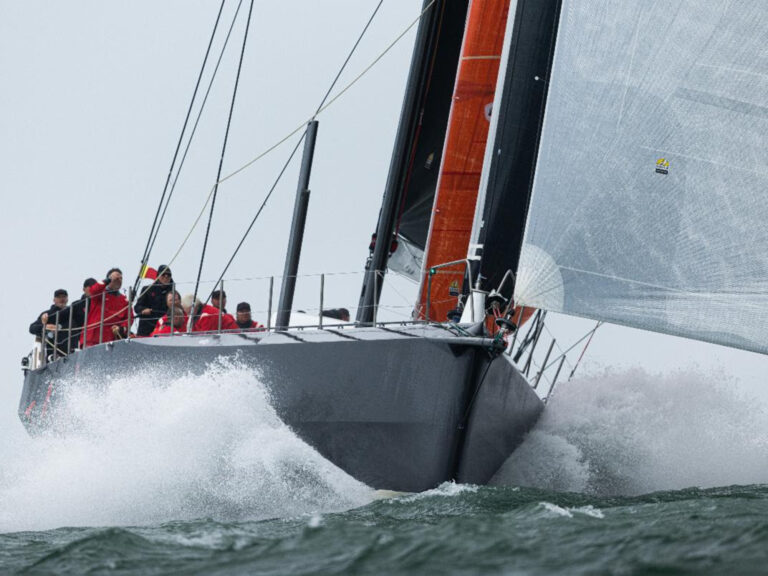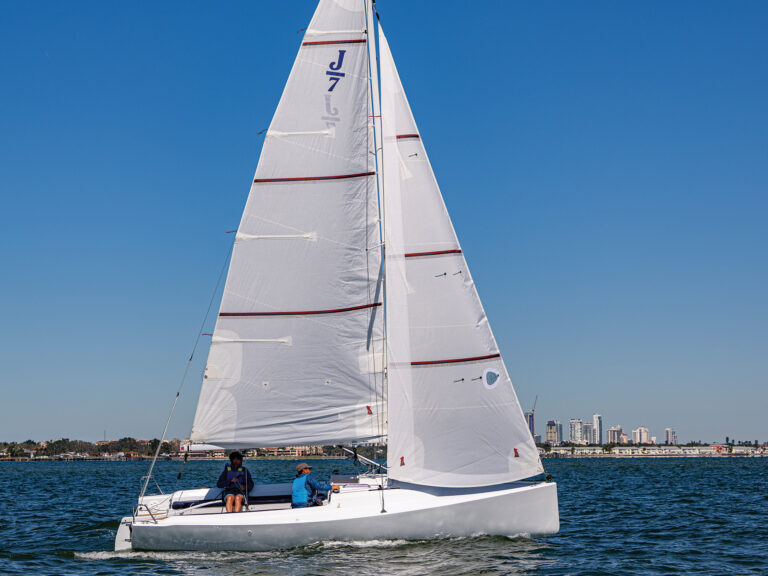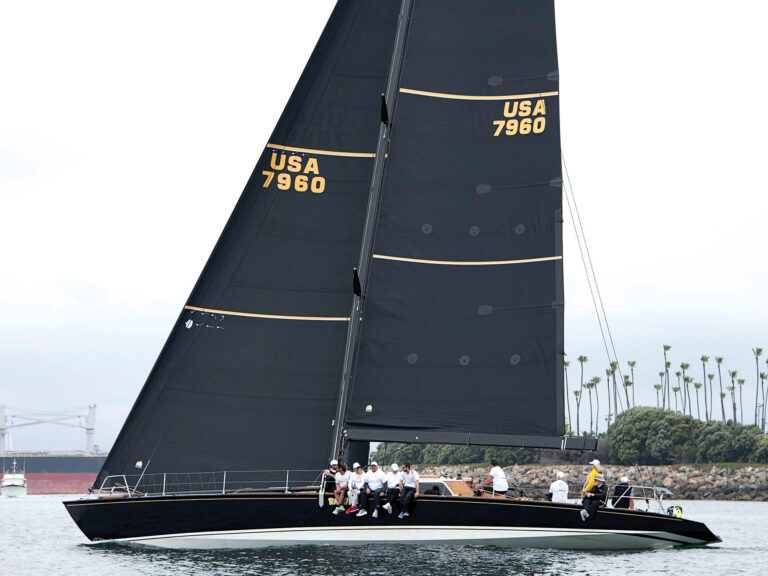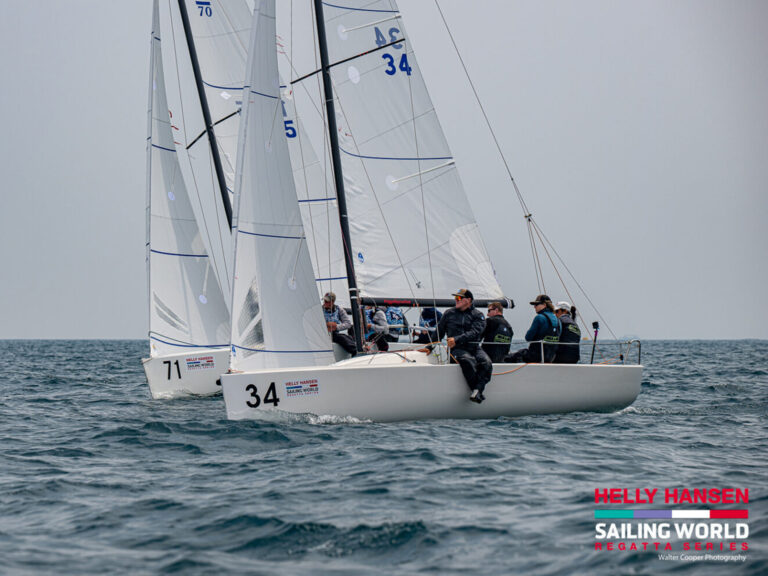
New Rules 3
In the first two parts of this series on the revised racing rules for 2005-2009, I covered the changes in the rules of Part 2-rules that apply when boats meet. Let’s now turn our attention to other changes that affect competitors during a race. Definition-Clear Astern and Clear Ahead; Overlap In the 2000-2004 edition of the rules, astute team racers noticed a logical flaw in the definition Clear Astern and Clear Ahead; Overlap that had escaped detection for more than 50 years. Two pairs of rules, Rules 11 and 12 and Rules 18.2(b) and (c), depend on a fundamental principle: Two boats may overlap, or one of them may be clear ahead and the other clear astern, but those two conditions must never occur at the same time. The 2004 definition is, in certain three-boat situations, inconsistent with that fundamental principle. The diagram below shows one such situation. Under both the old and the new definition, Barb and Al overlap and neither is clear ahead or clear astern of the other. The same can be said of Barb and Chuck. However, consider Al and Chuck. Under the 2004 definition, Al and Chuck overlap because Barb is between them and she overlaps both of them. However, Chuck’s entire boat is behind a line abeam from the aftermost point of Al’s boat and, therefore, Chuck is clear astern of Al and Al is clear ahead of Chuck. The 2005 definition has been changed to remove this inconsistency. For 2005 there is a new, separate sentence that covers the three-boat overlap situation shown in the diagram. It reads: “However, [two boats] also overlap when a boat between them overlaps both.” The use of “however” signals that the new sentence is an exception to what has come before it in the definition. Therefore, from now on when Al and Chuck are in the positions shown in the diagram, they overlap, and the terms clear ahead and clear astern do not apply to them. Definition Start and Rule 29 For 2005, old Rule 29.1 has been deleted and the definition Start has been changed to: “A boat starts when, having been entirely on the pre-start side of the starting line at or after her starting signal, and having complied with Rule 30.1 if it applies, any part of her hull, crew or equipment crosses the starting line in the direction of the first mark.” There are three reasons for these changes: (1) to eliminate an undesirable effect of the old definition and old Rule 29.1, (2) to eliminate an unnecessary rule, and (3) to make the definition Start consistent with the definition Finish and with the way sailors describe starting. The following example illustrates the undesirable effect of the old rules. Larry was on the course side of an extension of the starting line at the starting signal (position 1 in the diagram). Neither Flag I, Flag Z, nor the black flag had been displayed. Larry did not have to comply with old Rule 29.1 because he was on the course side of an extension of the line, not the line itself. Therefore, there was no requirement on him to “sail completely to the pre-start side of the line before starting.” Under the old definition Start, he started at position 2 when his bow first crossed the starting line, even though he had not returned completely to the pre-start side of the line and was crossing in the direction opposite to that to the first mark. Having started, he then sailed towards position 3 and the first mark. In 2005, if Larry is at position 1 at the starting signal, he will be required by Rule 28.1 to start. According to the new definition Start, he will have to sail to a position “entirely on the pre-start side of the starting line” and then cross the line in the direction of the course to the first mark.” Old Rule 29.1 is no longer necessary; its role is played by Rule 28.1’s requirement that Larry start and by the description of how to start in the new definition. Sculling-Rules 42.2 and 42.3 Sculling received intense study by the rule writers over the past two years. In 2004, Rule 42.2(d) prohibited “sculling: repeated movement of the helm not necessary for steering.” For 2005 that rule prohibits “sculling: repeated movement of the helm that is either forceful or that propels the boat forward or prevents her from moving astern.” However, new Rule 42.3(d) permits a boat to scull to turn to a close-hauled course when she is “above a close-hauled course and either stationary or moving slowly,” and new Rule 42.3(e) permits a boat to “reduce speed by repeatedly moving her helm.” New Rule 42.3(d) recognizes that, particularly in light winds, it is sometimes necessary to scull a boat onto a course on which she is able to sail forward. New Rule 42.3(e) allows an effective method of slowing a boat when, for example, you are gaining fast on boats that entered the two-length zone clear ahead of you. Rocking-Rules 42.2 and 42.3 In 2004, Rule 42.2(b) prohibited “rocking: repeated rolling of the boat, induced either by body movement or adjustment of the sails or centerboard, that does not facilitate steering.” Three changes have been made for 2005. (1) Repeated rolling of the boat induced by steering is now prohibited (Rule 42.2(b)(3)). (2) The word “repeated” has been added in front of “adjustment of the sails or centerboard.” This has the effect of allowing you to make one error in setting your sails or centerboard on a run. However, you break this new rule if yourepeatedly set your sails or centerboard so that your boat rolls. (3) The words “that does not facilitate steering” have been deleted from Rule 42.2(b), but there is a new Rule 42.3(a) that reads, “A boat may be rolled to facilitate steering.” This is a housekeeping change-it merely puts the exception aboutfacilitating steering into Rule 42.3, the rule that contains the exceptions to Rules 42.1 and 42.2. Penalties-Rules 44 and 31 The 720 Degree Turns Penalty for breaking a rule of Part 2 and the 360 Degree Turn Penalty for touching a mark have been changed for 2005. Now, to exonerate yourself after breaking a rule of Part 2 you are not required to turn through a full 720 degrees. Instead, you need only turn in a given direction (either clockwise or counter-clockwise) until you have made two tacks and two jibes. If you touch a mark, instead of turning a full 360 degrees you need only turn until you have made one tack and one jibe. These changes were made because judges observed boats that made the required tacks and jibes while taking a penalty, but failed to complete the required turns. For example, suppose that while sailing a windward-leeward course a boat that touched the windward mark “took” her penalty by beam reaching away from the mark until clear of other boats and then turned until she had tacked and jibed once and was on a run towards the leeward mark. She did not complete a 360 Degrees Turn Penalty because she did not luff up to a beam reach after her jibe. Today, provided she makes a tack and a jibe, a boat takes the penalty specified in new Rule 31.2, even if she does not turn a full 360 degrees. Changes have been made in Sportsmanship and the Rules and in Rules 31.2 and 44.2 to make it clear that if a boat retires from a race she has taken a penalty. Furthermore, Rule 44.2 now states that a boat that breaks a rule and as a result causes “injury or serious damage or gained a significant advantage in the race or series” may exonerate herself only by retiring at the time of the incident; the new Two-Turns Penalty (formerly 720 Degree Turns Penalty) will not exonerate her. What’s new here is the addition of “injury” as one of the conditions under which retiring is the only means of exoneration available. (Similar changes have been made in Rules 14(b) and 62.1(b).) E-mail for Dick Rose may be sent to [email protected].

